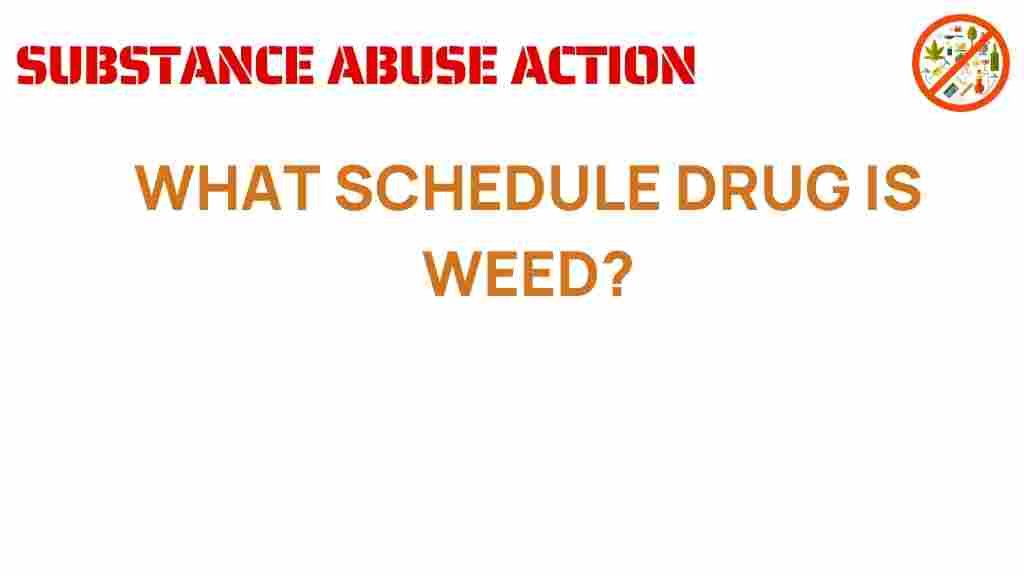Unraveling the Mysteries: What Schedule Drug is Weed?
Marijuana, also known as cannabis, has been a topic of heated debate for decades. As a Schedule Drug, its classification raises numerous questions about legality, health effects, and public perception. This article aims to unravel the mysteries surrounding marijuana, exploring its status as a Schedule Drug, its legal implications, health effects, and how society views it today.
The Classification of Marijuana as a Schedule Drug
Marijuana is classified under the Controlled Substances Act, which categorizes drugs into five schedules based on their potential for abuse, accepted medical use, and safety or dependence liability. As of now, marijuana is classified as a Schedule I drug, which indicates the following:
- High potential for abuse: Schedule I drugs are considered to have a high potential for addiction.
- No accepted medical use: These substances are deemed to have no accepted medical applications in the United States.
- Lack of accepted safety: There is a lack of accepted safety for use under medical supervision.
This classification is a significant barrier to research and medical use, impacting how marijuana is perceived in society.
The Legal Landscape of Marijuana
The legality of marijuana varies widely across different states and countries. In the United States, while it remains a Schedule I drug federally, many states have decriminalized or legalized its use for medicinal and recreational purposes. Here are some key points regarding marijuana legality:
- State Laws: Over 30 states have legalized marijuana for medical use, and several have legalized it for recreational use.
- Federal Laws: Despite state-level legalization, marijuana remains illegal at the federal level, creating a complex legal landscape.
- International Laws: Different countries have varying regulations; some have fully legalized cannabis, while others maintain strict prohibitions.
Understanding these legal nuances is crucial for anyone looking to use or invest in marijuana.
Health Effects of Marijuana
The health effects of marijuana are widely discussed and range from therapeutic benefits to potential risks. Here’s what you need to know:
Positive Health Effects
Research has indicated several potential health benefits of marijuana:
- Pain Relief: Many patients use marijuana to alleviate chronic pain.
- Anti-inflammatory Properties: Cannabis may help reduce inflammation, which can benefit conditions like arthritis.
- Neurological Disorders: Some studies suggest that marijuana may help with conditions such as epilepsy and multiple sclerosis.
Negative Health Effects
Despite the potential benefits, marijuana use comes with risks:
- Addiction: Contrary to popular belief, marijuana can be addictive. Studies suggest that about 9% of users may become dependent on it.
- Cognitive Impairment: Regular marijuana use can lead to impaired memory and cognitive functions, especially in young users.
- Respiratory Issues: Smoking marijuana can lead to respiratory problems similar to those caused by tobacco.
It’s essential to weigh these health effects when considering marijuana use.
Public Perception of Marijuana
Public perception of marijuana has evolved significantly over the years. Here are some factors influencing current views:
- Media Representation: Increasing coverage of marijuana’s medical benefits has contributed to a more positive public perception.
- Advocacy Groups: Organizations advocating for legalization have raised awareness about the potential benefits and pushed for changes in legislation.
- Generational Shifts: Younger generations tend to be more open to marijuana use compared to older populations.
As a result, many people now view marijuana more favorably than in previous decades.
Addiction and Treatment Options
Understanding addiction and available treatment options is critical for those struggling with marijuana dependence. Here’s an overview:
Recognizing Addiction
Signs of marijuana addiction can include:
- Increased tolerance to marijuana.
- Withdrawal symptoms when not using.
- Continued use despite negative consequences.
Treatment Options
If you or someone you know is struggling with marijuana addiction, several treatment options are available:
- Cognitive Behavioral Therapy (CBT): This therapy helps individuals understand and change their thought patterns related to drug use.
- Support Groups: Groups like Marijuana Anonymous offer a community for those seeking recovery.
- Outpatient Programs: These programs provide structured treatment while allowing individuals to maintain their daily routines.
Seeking help is crucial for recovery and can lead to a healthier lifestyle.
Conclusion
Marijuana remains a complex subject, entangled in discussions about its classification as a Schedule Drug, legal status, health effects, and societal perceptions. As more states and countries reconsider their laws regarding cannabis, the dialogue surrounding marijuana will continue to evolve.
Whether you’re considering marijuana for medical use, exploring its legal implications, or addressing addiction, it’s vital to stay informed and seek guidance when necessary. For further information on cannabis regulations, you can visit this resource. Additionally, if you’re looking for treatment options for marijuana dependence, reach out to local health services or visit this link for support.
Ultimately, understanding the multifaceted nature of marijuana will empower individuals to make informed decisions about its use and navigate the complexities of its legality and health implications.
This article is in the category Health and created by SubstanceAbuseAction Team
